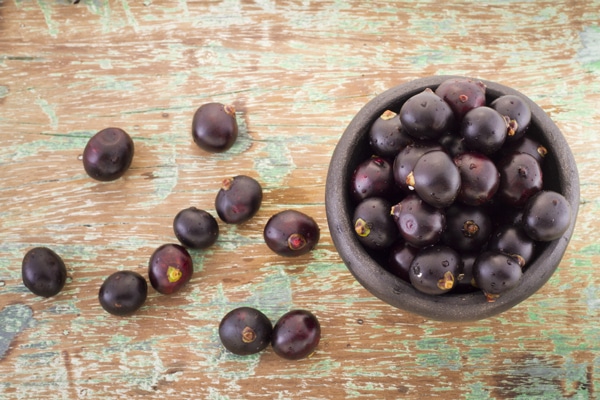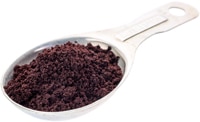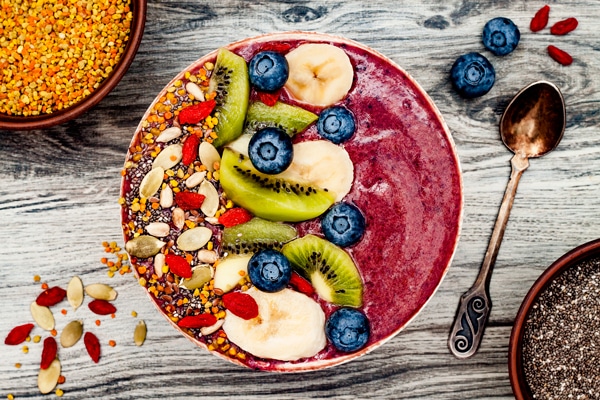Acai berries are a Brazilian “superfruit.”
They’re native to the Amazon region where they’re a staple food.
However, they’ve recently gained popularity globally and are praised for being particularly beneficial to health and well-being.
This dark purple fruit certainly packs a lot of nutrition, and it may even have some health benefits, including the 5 described in this article.
What Are Acai Berries?

Acai berries are 1-inch (2.5-cm) round fruits that grow on acai palm trees in the rainforests of Central and South America. They have a dark purple skin and yellow flesh surrounding a large seed.
Because they contain pits like apricots and olives, they’re technically not a berry, but rather a drupe. Nevertheless, they’re commonly referred to as berries.
In the Amazon rainforest, acai berries frequently accompany meals.
To make them edible, they are soaked to soften the tough outer skin and then mashed to form a dark purple paste.
They have an earthy taste that’s often described as a cross between blackberries and unsweetened chocolate.
Fresh acai berries have a short shelf life and aren’t available outside of where they are grown. As an export, they are sold as a frozen fruit purée, dried powder or pressed juice.
Acai berries are also sometimes used to flavor food products, including jelly beans and ice cream, while some non-food items like body creams contain acai oil.
Summary: Acai berries grow on acai palm trees in the Amazon rainforest. They’re processed into a pulp before eating.
1. They’re Nutrient-Dense
Acai berries have a unique nutritional profile for a fruit, as they’re somewhat high in fat and low in sugar.
100 grams of frozen fruit pulp has the following nutritional breakdown (1):
- Calories: 70
- Fat: 5 grams
- Saturated fat: 1.5 grams
- Carbs: 4 grams
- Sugar: 2 grams
- Fiber 2 grams
- Vitamin A: 15% of the RDI
- Calcium: 2% of the RDI
According to a Venezuelan study, acai berries also contain some other trace minerals, including chromium, zinc, iron, copper, manganese, magnesium, potassium and phosphorus (2).
But some of acai’s most powerful health benefits come from plant compounds.
The most notable one among these is anthocyanins, which give acai berries their deep purple color and act as antioxidants in the body.
You can also find anthocyanins in other blue, black and purple foods, such as black beans and blueberries.
Summary: Acai berries contain healthy fats and low amounts of sugar, as well as many trace minerals and plant compounds, including anthocyanins.
2. They’re Loaded With Antioxidants

Antioxidants are important because they neutralize the damaging effects of free radicals throughout the body.
If free radicals are not neutralized by antioxidants, they can damage cells and lead to a number of diseases, including diabetes, cancer and heart disease (3).
Acai berries have an incredibly high amount of antioxidants, edging out other antioxidant-rich fruits like blueberries and cranberries (4).
The antioxidant content of foods is typically measured by an Oxygen Radical Absorbance Capacity (ORAC) score.
In the case of acai, 100 grams of frozen pulp has an ORAC of 15,405, whereas the same amount of blueberries has a score of 4,669 (4).
These antioxidants come from a number of plant compounds in acai, including anthocyanins (5, 6).
In 2008, researchers gave 12 fasting volunteers acai pulp, acai juice, applesauce or a drink with no antioxidants at four different times and then tested their blood for antioxidants (7).
Both the acai pulp and applesauce raised participants’ antioxidant levels, which means that the antioxidant compounds in acai are well-absorbed in the gut (7).
It also indicates that acai pulp is a better source of antioxidants than acai juice.
Summary: Acai is incredibly rich in antioxidants, boasting three times the amount found in blueberries.
3. They May Improve Cholesterol Levels
Animal studies have suggested that acai could help improve cholesterol levels by decreasing total and LDL cholesterol (8, 9, 10).
And it’s possible that it could have a similar effect in humans.
A 2011 study had 10 overweight adults eat acai smoothies twice daily for one month. Overall, they had lower total and “bad” LDL cholesterol at the end of the study (11).
However, there were a few drawbacks to this study. It was small, had no control group and received its funding from a primary supplier of acai.
While more research is needed, it’s possible that the anthocyanins in acai could be responsible for their positive impact on cholesterol levels, since studies have linked this plant compound to improvements in HDL and LDL cholesterol (12).
In addition, acai contains plant sterols, which prevent cholesterol from being absorbed by your body (10).
Summary: Many animal studies and at least one human study have suggested that acai may help lower blood cholesterol levels.
4. They May Have a Possible Anti-Cancer Effect

While no one food is a magic shield against cancer, some foods are known to stop cancer cells from forming and spreading.
Both test-tube and animal studies have revealed this sort of anti-cancer effect in acai (13, 14, 15, 16, 17).
In mice, acai pulp has reduced the incidence of colon and bladder cancer (14, 15).
However, a second study in mice found that it had no effect on stomach cancer (18).
Researchers have concluded that acai could have a role in treating cancer in the future, yet more research is needed, including in humans.
Summary: In animal and test-tube studies, acai has shown potential as an anti-cancer agent. More studies are needed to determine its effect in humans.
5. They Could Boost Brain Function

The many plant compounds in acai could also protect your brain from damage as you age (19).
Several studies have shown this kind of protective effect in lab rats (19, 20, 21, 22).
The antioxidants in acai counteract the damaging effects of inflammation and oxidation in brain cells, which can negatively affect memory and learning (21).
In one study, acai even helped improve memory in aging rats (22).
One of the ways in which the brain stays healthy is by cleaning up cells that are toxic or no longer working, a process known as autophagy. It makes way for new nerves to form, enhancing communication between brain cells.
As you age, this process works less efficiently. However, in lab tests, acai extract has helped stimulate this “housekeeping” response in brain cells (23).
Summary: Acai may counteract the damaging effects of inflammation and oxidation in the brain and help stimulate its “housekeeping” response.
Possible Drawbacks to Acai Berries
Given that acai is a healthy, antioxidant-rich fruit, there aren’t a whole lot of drawbacks to eating it.
However, one word of caution is to not overestimate its associated health claims.
While the initial research is promising, studies on its effects on human health have been small and scarce.
Therefore, it’s important to take the health claims with a grain of salt.
Also, keep in mind that if you’re buying it as a pre-processed pulp, check the ingredient label and make sure it doesn’t have added ingredients.
Some of the purées have a very high amount of added sugar.
Summary: For the most part, acai is a healthy fruit with few drawbacks. Make sure to watch out for added sugars in acai purées.
How to Eat Acai

Since fresh acai berries have a short shelf life, they’re mainly exported and widely available in three main forms — purées, powders and juices.
The juice is loaded with antioxidants, but it’s also the highest in sugar and lacking in fiber. Although, if filtered, the juice may contain fewer antioxidants (7).
The powder delivers the most concentrated amount of nutrients, giving you fiber and fat, as well as plant compounds.
That being said, the purée is probably the best way to enjoy the flavor of acai berries.
To make an acai bowl, blend unsweetened frozen purée with water or milk to turn it into a smoothie-like base for toppings.
Toppings may include sliced fruit or berries, toasted coconut flakes, nut butters, cocoa nibs or chia seeds.
You can also make a bowl using acai powder. Blend it into your favorite smoothie recipe, then top with your favorite add-ins.
The powder is a versatile ingredient that you can add to oatmeal, salad dressings or granola.
Or try making healthy truffles by blending it with nuts and dates.
Summary: There are several ways to eat acai, including as a frozen purée, powder or juice.
The Bottom Line
Thanks to their high antioxidant content, acai berries have many potential health benefits.
They’re loaded with powerful plant compounds that act as antioxidants and could have benefits for your brain, heart and overall health.
They also deliver healthy fats and fiber, making them a generally healthy food.
Enjoy acai as a smoothie or bowl, but watch out for the added sugars that are often found in the juices and frozen purées.






